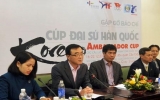Champa translations shed light on origins
It's the first ever English and Vietnamese version of 13th century inscriptions of the Champa Kingdom. It depicts the history of Dai Viet (Great Viet) and the Champa Kingdom. The book is the result of a three-year project to translate all the inscriptions from dozens of stellae into English and Vietnamese. It has been handed over to Da Nang-based Cham Sculpture Museum. "It was a long and hard project to search for the Cham inscriptions. My French and Vietnamese colleagues translated the oldest Cham inscriptions from objects at the Cham Sculpture Museum," said the book's co-author Arlo Griffiths from the French School of Asian Studies. "The book will be a precious source of history for the Dai Viet, or Great Viet (the former name of Viet Nam under the rule of the Ly dynasty), the Champa Kingdom and the Southeast Asian region," said Griffiths from the Netherlands, who trained in Indian studies – with a focus on Sanskrit – at the University of Leiden and at Harvard. However, he admitted that he had failed to translate badly damaged inscriptions in the My Son sanctuary. Launched in 2009, Corpus of Inscriptions of Champa is the continuation and updating of an inventory of inscriptions from the Kingdom of Champa begun by the French School of Asian Studies in 1923. Nguyen Thanh Xuan, a Vietnamese translator, said he took one month to translate the book from English into Vietnamese. "It's a complete collection of inscriptions from the Champa Kingdom. All inscriptions, which were found at Cham towers in the My Son sanctuary, Quang Tri and Quang Nam provinces, tell stories and history of the Kingdom," Xuan said. "Inscriptions also describe the trading between the Cham people with communities in the now Central Highlands region," he said. The book's Vietnamese version translator also said inscriptions found at the Cham towers were focused on the worship of Shiva, and kings of the Champa Kingdom. The book's co-author Thanh Phan, of Cham descent, said he and colleagues also took words from fragments of brick carvings as well as metal objects at the My Son sanctuary, Ninh Thuan, Khanh Hoa and Quang Nam. He said the oldest inscription in the ancient Cham language is displayed in the backyard of Viet Nam National Museum of History in Ha Noi. Many towers from the Champa Kingdom, which ruled the central coast region between the fourth and 13th centuries, remain undiscovered in the area.
VNSVietnam Festival of Creativity & Design on the horizon
 Young chess masters to compete at world championships in Brazil
Young chess masters to compete at world championships in Brazil
Vietnamese player takes world three-cushion billiards trophy
UNESCO official applauds Ninh Binh for heritage value promotion
 Hung Thinh Cup Binh Duong Football Tournament 2024 kicks off
Hung Thinh Cup Binh Duong Football Tournament 2024 kicks off
42 Vietnamese movies to compete at 7th Hanoi Int’l Film Festival
 Over 100 burials from 4000 years ago discovered in Hanoi
Over 100 burials from 4000 years ago discovered in Hanoi
 Rocktober 2024 attracts climbing enthusiasts
Rocktober 2024 attracts climbing enthusiasts
Vietnam Jungle Marathon welcomes runners from around the world
 Vietnam Jungle Marathon welcomes runners from around the world
Vietnam Jungle Marathon welcomes runners from around the world




